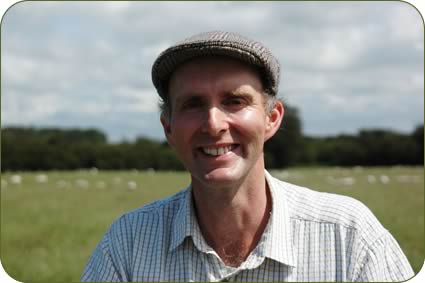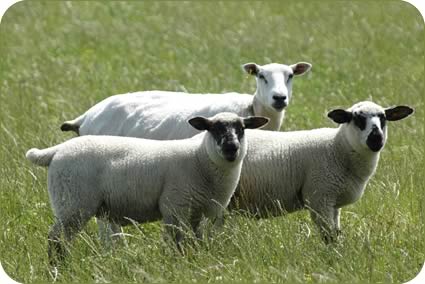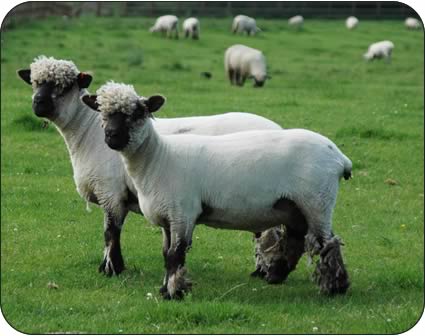Jennifer MacKenzie is an agricultural photo journalist with almost 30 year's experience. Operating from her base in Cumbria, Jennifer undertakes mainly industry-related freelance writing and photography.
Oxford Down - Ease of Management
Ease of management, early lambing and superior eating quality of finished lambs are just some of the attributes of the Oxford Down which has kept Andrew Rutherford faithful to the traditional British breed for the last two decades.
While the Oxford Down is classified as a minority breed by the Rare Breeds Survival Trust, renewed interest in traditional breeds of sheep and cattle has led to an increase in numbers and there are now 70 pedigree flocks in the UK.
Andrew is adopting the latest in technology to improve his Oxford Down flock by performance recording all ewes and rams as well as by speeding up genetic progress with embryo transfer to improve progeny both for sale and rams for use on the commercial flock of 500 Lleyn ewes.
The MV accredited pedigree flock is run on the 360-acre Guards Farm, Gretna, which lies between the Rivers Sark and Esk as they enter the Solway Estuary.
 |
| Andrew Rutherford |
The pedigree Oxford Langrigg flock was established in 1987 alongside a pedigree Suffolk flock of the same prefix founded in 1949, a common practice at the time among Suffolk breeders, using the Oxfords to sweep up any late ewes.
Both flocks were lost in the 2001 foot and mouth epidemic with the pedigree Suffolks numbering 120 ewes and the Oxfords about 60 ewes.
Testament to the popularity of the Oxford, Andrew, who farms with his parents Robert and Winnie and sister Jane, re-stocked with Oxfords with the flock at 40 purebreds now outnumbering the Suffolks at 25 ewes.
The replacement flock was founded from the purchase of females from Yorkshire breeder Geoff Riby’s celebrated Ribwood flock.
Andrew, the Oxford Down Sheep Breeders’ Association immediate past president, hopes to build on the bloodlines to make the flock as successful as in the 1990s when rams were selling up to 450gns at Kelso Ram Sale.
Andrew has performance recorded the pedigree flocks for a couple of years. “It’s interesting to see that there is quite a variation even in such a small gene pool on measurements such as muscle and fat depth which I am particularly interested in when using the rams commercially,” said Andrew.
“While currently there are few Oxford flocks which are recorded, I am trying to buy rams from a variety of bloodlines which I can evaluate within my flock.
“I’m looking to improve the eye muscle without losing too much fat which gives the lamb flavour.
“I’m recording for my own use as I use up to nine Oxford rams on my commercial flock. If by using rams with better figures translates to an extra few pounds a finished lamb then it’s a benefit to me.
“If you are using a ram that produces 38mm of eye muscle depth with 3 to 4mm of fat it will be a lot more desirable for the market than one with 10mm of fat,” he said.
 |
| Lleyn ewe with Oxford cross lambs |
Andrew sees the cost of recording which amounts to around £300 a year as a worthwhile investment as he also does with embryo transfer work carried out by Ovibreed, of Springholm, Castle Douglas.
“AI and embryo work looks expensive but we have got to embrace modern technology. A good ewe can produce the equivalent of four or five lamb crops in a year with ET and there is no other way to achieve this. We have recently flushed a very correct home-bred ewe which was out of a Worcester champion and she has produced good lambs,” said Andrew.
“If, like me, you want to get involved in preserving the breed you need to make investments in it.”
As well as the Oxford ewes being docile and easily managed and lambed, the breed has a high scrapie resistance. Results from flocks which have joined the National Scrapie Plan have shown that 97 per cent of Oxford Downs tested possessed one or other of the two genotypes representing the highest level of scrapie resistance.
All the sheep on the farm are MV accredited and the Lleyn was selected as the ewe for the commercial flock to avoid importing disease onto the farm by buying in female replacements. The ewes are also prolific and easy to manage.
The Lleyns are crossed with both Oxford and Suffolk rams and this autumn some of the Suffolk crosses are being put to the Oxford.
The pedigree flocks start lambing with the Oxfords at the end of December and the Suffolks beginning in early January.
Rams and gimmers are sold both at the Worcester sale at the end of July and at the Carlisle Rare Breeds sale in September.
Rams are sold at the Kelso Ram Sale and the NSA Builth Wells Ram Sale, both in September. Ram lambs are usually used on the flock before being sold on as shearlings. However, this year some shearlings will be retained as stock rams to cover a larger number of ewes.
The commercial flock begins lambing on March 20 with some lambing at the end of January to produce lambs for special events such as next year’s Scotsheep which is being held in the Borders.
Early lambs are sold by the end of May through Longtown Mart and while suffering from a depressed prime lamb trade this spring, last year the lambs were consistently making £60 a head at 40kg or more.
 |
| Oxford Down Ewes |
Oxford cross lambs have an unrivalled weight for age with typically lean 18-22kg carcases at 12 to 16 weeks old. An Aberdeenshire breeder who is using a Langrigg-bred ram had the grading results shown in Table 1 for his first batch of Oxford spring lambs sold deadweight in early April.
“The Oxford is early lambing and soon gets to weight so they are ideal for capitalising on the early lamb market. The majority of our early lambs are off the farm by the end of June. Our lambing percentage for the crossbreds averages 170 to 180.
“Some of the new converts to the breed are selling their lamb to niche premium markets or through their own farm shops, taking advantage of the traditional breed’s meat flavour and eating qualities.”
With around 1,500 breeding ewes throughout the UK it qualifies for the “native breeds at risk” payment within Defra’s stewardship schemes.
Much of Guards Farm is only 5 metres above sea level and up to 40 acres is flooded regularly at peak times by the estuary.
Oats are grown for the sheep and roots are grown for the ewes which because of their good feet can withstand wintering on them. The sheep are also fed haylage.
The farm also has a small number of suckler cows which are being phased out in favour of sheep.
Table 1: Grading results for Oxford lambs sold April 2007
|
Age |
Carcase weight (kg) |
Grade |
16 |
19.1kg |
R3H |
16 |
23.1kg |
R3H |
14 |
20.7kg |
R4L |
12 |
19.2kg |
R3H |
14 |
24.0kg |
U3H |

